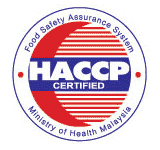
Hazard analysis and critical control points, or HACCP, is a systematic preventive approach to food safety and pharmaceutical safety that identifies physical, allergenic, chemical, and biological hazards in production processes that can cause the finished product to be unsafe, and designs measurements to reduce these risks to a safe level. In this manner, HACCP is referred as the prevention of hazards rather than finished product inspection. The HACCP system can be used at all stages of a food chain, from food production and preparation processes including packaging, distribution, etc. The Food and Drug Administration (FDA) and the United States Department of Agriculture (USDA) say that their mandatory HACCP programs for juice and meat are an effective approach to food safety and protecting public health. Meat HACCP systems are regulated by the USDA, while seafood and juice are regulated by the FDA. The use of HACCP is currently voluntary in other food industries.
HACCP is believed to stem from of a production process monitoring used during World War II because traditional "end of the pipe" testing on artillery shell's firing mechanisms could not be performed, and a large percent of the artillery shells made at the time were either duds or misfiring. HACCP itself was conceived in the 1960s when the US National Aeronautics and Space Administration (NASA) asked Pillsbury to design and manufacture the first foods for space flights. Since then, HACCP has been recognized internationally as a logical tool for adapting traditional inspection methods to a modern, science-based, food safety system. Based on risk-assessment, HACCP plans allow both industry and government to allocate their resources efficiently in establishing and auditing safe food production practices. In 1994, the organization of International HACCP Alliance was established initially for the US meat and poultry industries to assist them with implementing HACCP and now its membership has been spread over other professional/industrial areas.
Hence, HACCP has been increasingly applied to industries other than food, such as cosmetics and pharmaceuticals. This method, which in effect seeks to plan out unsafe practices based on science, differs from traditional "produce and sort" quality control methods that do nothing to prevent hazards from occurring and must identify them at the end of the process. HACCP is focused only on the health safety issues of a product and not the quality of the product, yet HACCP principles are the basis of most food quality and safety assurance systems,and the United States, HACCP compliance is regulated by 21 CFR part 120 and 123. Similarly, FAO/WHO published a guideline for all governments to handle the issue in small and less developed food businesses.
The HACCP seven principles
Principle 1: Conduct a hazard analysis. – Plans determine the food safety hazards and identify the preventive measures the plan can apply to control these hazards. A food safety hazard is any biological, chemical, or physical property that may cause a food to be unsafe for human consumption.
Principle 2: Identify critical control points. – A critical control point (CCP) is a point, step, or procedure in a food manufacturing process at which control can be applied and, as a result, a food safety hazard can be prevented, eliminated, or reduced to an acceptable level.
Principle 3: Establish critical limits for each critical control point. – A critical limit is the maximum or minimum value to which a physical, biological, or chemical hazard must be controlled at a critical control point to prevent, eliminate, or reduce to an acceptable level.
Principle 4: Establish critical control point monitoring requirements. – Monitoring activities are necessary to ensure that the process is under control at each critical control point. In the United States, the FSIS is requiring that each monitoring procedure and its frequency be listed in the HACCP plan.
Principle 5: Establish corrective actions. – These are actions to be taken when monitoring indicates a deviation from an established critical limit. The final rule requires a plant's HACCP plan to identify the corrective actions to be taken if a critical limit is not met. Corrective actions are intended to ensure that no product injurious to health or otherwise adulterated as a result of the deviation enters commerce.
Principle 6: Establish procedures for ensuring the HACCP system is working as intended. – Validation ensures that the plants do what they were designed to do; that is, they are successful in ensuring the production of a safe product. Plants will be required to validate their own HACCP plans. FSIS will not approve HACCP plans in advance, but will review them for conformance with the final rule.
Verification ensures the HACCP plan is adequate, that is, working as intended. Verification procedures may include such activities as review of HACCP plans, CCP records, critical limits and microbial sampling and analysis. FSIS is requiring that the HACCP plan include verification tasks to be performed by plant personnel. Verification tasks would also be performed by FSIS inspectors. Both FSIS and industry will undertake microbial testing as one of several verification activities.
Verification also includes 'validation' – the process of finding evidence for the accuracy of the HACCP system (e.g. scientific evidence for critical limitations).
Principle 7: Establish record keeping procedures. – The HACCP regulation requires that all plants maintain certain documents, including its hazard analysis and written HACCP plan, and records documenting the monitoring of critical control points, critical limits, verification activities, and the handling of processing deviations.
Standards
The seven HACCP principles are included in the international standard ISO 22000 FSMS 2005. This standard is a complete food safety and quality management system incorporating the elements of prerequisite programmes(GMP & SSOP), HACCP and the quality management system, which together form an organization's Total Quality Management system.
Applied range
It can apply to several food categories; sea food, bulk milk production line, Bulk Cream and Butter Production Line, animal meat industry, Organic Chemical Contaminants in Food, Corn Curl Manufacturing Plant, etc.





